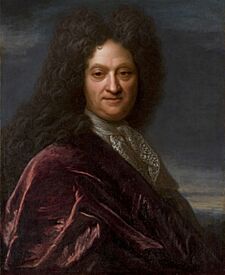Pierre Le Pesant, sieur de Boisguilbert facts for kids
Quick facts for kids
Boisguilbert
|
|
|---|---|

Pierre le Pesant, sieur de Boisguilbert
|
|
| Born | 17 February 1646 |
| Died | 10 October 1714 (aged 68) Rouen
|
| Nationality | French |
| Field | Political economics |
| School or tradition |
Physiocrats |
Pierre le Pesant, sieur de Boisguilbert (born February 17, 1646 – died October 10, 1714) was a French lawmaker. He was also a Jansenist, which was a religious movement. He is known as one of the first people to think about how an economic market works.
Contents
Early Life and Career
Pierre le Pesant was born in Rouen, France. His family was an old noble family from Normandy. He was related to the famous writer Pierre Corneille.
He studied in Rouen and at the Petites écoles de Port-Royal. Later, he became a judge in Montivilliers, a town near Le Havre. In 1690, he became the president of the bailliage of Rouen. A bailliage was like a local court and administrative area. He kept this important job almost until he died.
Boisguilbert's Ideas on Taxation
In his jobs, Boisguilbert carefully studied how the local economy worked. He even looked after his own lands. He also talked with important merchants in Rouen. This made him see how much people suffered because of heavy taxation.
The Problem with Taxes
In 1695, he wrote a main book called Le détail de la France. In this book, he described how badly all people in France were doing. He believed this was caused by a bad economic system.
At that time, many people followed Colbert's ideas, called mercantilist views. Mercantilism meant a country's wealth came from having a lot of money, especially gold and silver. But Boisguilbert disagreed. He thought a country's real wealth came from what it produced and traded.
His Solutions for France
Boisguilbert believed the solution was not just to lower taxes. Instead, taxes needed to be fair for everyone. If poor people had less tax to pay, they could buy more goods. This would help businesses produce more and make the whole country richer.
He asked for changes to the taille, which was a main tax. He also wanted to get rid of taxes on goods moving within France. He wanted more freedom for trade.
In another book, Factum de la France, he explained his ideas more simply. He suggested replacing many taxes with one single tax. This tax would be a tenth (10%) of the income from all property. However, people who collected taxes (called tax farmers) did not like this idea. It also did not get much support from others.
Challenges and Later Influence
Boisguilbert's writings were not easy to read. Because of this, his work was often ignored. A famous writer, Saint-Simon, told a story about Boisguilbert. Boisguilbert tried to talk to a powerful official, the comte de Pontchartrain. Boisguilbert said the official would first think he was foolish, then see his ideas were good, and finally be happy with his plan. Pontchartrain just laughed and turned away.
There was a plan to try Boisguilbert's ideas in one part of France. This was with Michel de Chamillart, another official. But the plan was stopped. People worried it would cause the current tax system to completely break down.
In 1707, another important book was published by Vauban. This book, La Dîme royale, had ideas similar to Boisguilbert's. Boisguilbert then published a follow-up to his own book. Both Vauban's and Boisguilbert's books were officially criticized. Boisguilbert was even sent away to Auvergne for six months as a punishment.
Finally, in 1710, a new tax was created by Nicolas Desmarets. This tax, called the dixième (the tenth), was a bit like Boisguilbert's idea. However, instead of replacing old taxes, Desmarets simply added this new tax on top of them.

